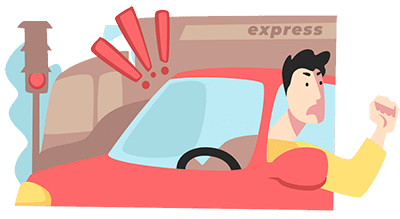Quiz: Aggressive driving and road rage
ADVERTISEMENT
Correct!
Wrong!
Correct!
Wrong!
Correct!
Wrong!
Correct!
Wrong!
Correct!
Wrong!
Correct!
Wrong!
Correct!
Wrong!
Share the quiz to show your results !
Subscribe to see your results
I got %%score%% of %%total%% right
More Learning Options:
Loading…
ADVERTISEMENT
The Dangers of Aggressive Driving and Road Rage
Perhaps you’re running late for work or an appointment and get caught in a traffic jam. Or maybe another driver cuts you off. How would you react? Driving is not without its own set of challenges, but getting angry on the road can lead to aggressive behavior, distracted driving, or even cause an accident.
What Is Road Rage?
Road rage is a type of aggressive driving that includes tailgating, weaving, and speeding. Road rage could also be called aggressive driving, and the most common forms include:
- Tailgating
- Yelling
- Failing to yield the right-of-way
- Gesturing and honking at other drivers
- Going so far as to start a physical confrontation
- Weaving In and Out of Traffic
- Driving on the shoulder
- Running stoplights or stop signs.
- Slamming On the Brakes
- Following too closely
 Road Rage Factors
Road Rage Factors
Here are some factors that often contribute to road rage or aggressive driving behavior. They include:
- Traffic delays: Traffic jams, sitting at stoplights, stop signs, and looking for a parking space can increase a driver’s anger level.
- Running late: Being late for work or an appointment can cause impatience
- Anonymity: When a driver sees others as strangers whom they don’t know or are unlikely to interact with on a personal level, they may not mind engaging in risky behavior such as cutting people off, tailgating, excessive honking, and making impolite gestures.
- Disregarding the law and others: Some drivers lack discipline and respect for other road users and may think the rules do not apply to them.
- Habitual or learned behavior: Aggressive driving may seem like a normal thing for some drivers.
What Are the Dangers of Aggressive Driving?
Aggressive driving can have serious consequences for you or others, including death. Dangerous behaviors such as tailgating and cutting someone off could easily cause an accident. In fact, aggressive driving is one of the leading causes of accidents, which means that people who engage in these kinds of behaviors are putting their own lives at risk. According to a report by the AAA Foundation for Traffic Safety, aggressive driving incidents are responsible for over 218 murders and 12,610 injuries in a period of seven-year.
However, road rage and accidents that result from it can be prevented by keeping your emotions under control and being mindful of other road users. Here are tips to avoid aggressive driving:
- Plan ahead and expect delays.
- Be vigilant and considerate. Focus on your own driving.
- Don’t let your emotions get the best of you. Don’t get angry.
- Avoid distractions, such as using cell phones while driving.
- Don’t tailgate or cut off other drivers, as this could lead to an accident.
- Stay calm and drive carefully; keep your emotions in check. If you are frustrated and angry, you may not be able to think clearly.
- Avoid honking at other drivers – this can make them angry and is a distraction for both you and other drivers on the road.
- If you have witnessed aggressive driving, call the police.
Taking a course in defensive driving can help you stay safe on the road and could also help you qualify for discounts on car insurance!

 Road Rage Factors
Road Rage Factors